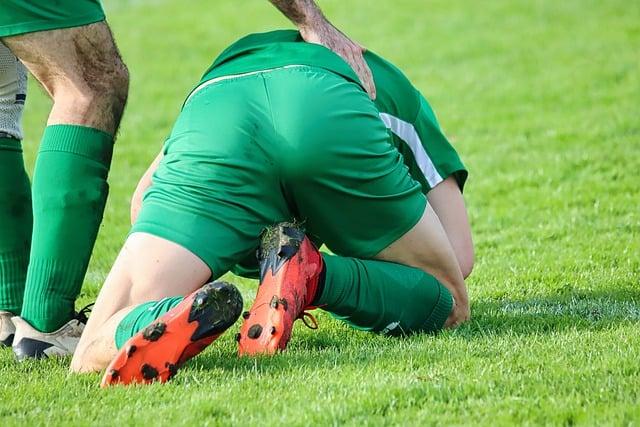Safeguarding Athletes: Insights into Sports Injury Prevention and recovery
Injuries sustained during athletic activities, whether on the field, court, or track, can substantially hinder both performance and overall health for athletes and fitness enthusiasts. As sports gain traction among various age demographics, it becomes increasingly vital to comprehend effective strategies for preventing and managing sports-related injuries. The National Institutes of Health (NIH), through its National Institute of Arthritis and Musculoskeletal and Skin Diseases (NIAMS), provides a wealth of facts that serves as an essential guide for athletes, coaches, and caregivers navigating the complexities associated with these injuries. This comprehensive resource aims to educate individuals about injury prevention techniques, treatment options available, and rehabilitation methods necessary to maintain an active lifestyle safely. In this article, we will explore NIAMS’s latest insights on sports injuries while highlighting how this resource can cultivate a culture centered around health and safety in athletics.
Common Sports Injuries: Understanding Risks & Prevention Techniques
Sports-related injuries are common across all levels of athletic participation; they often lead to missed competitions or extended recovery times. Some prevalent types of injuries include sprains, strains, fractures, and concussions. Grasping the underlying causes of these injuries is essential for effective prevention. Sprains occur when ligaments are overstretched or torn due to sudden movements or inadequate warm-up routines; strains involve similar damage but affect muscles instead. Fractures may result from repetitive stress or falls during play while concussions—traumatic brain injuries—often arise from impacts in contact sports.
The implementation of robust preventive measures can greatly diminish the likelihood of sustaining such injuries. Athletes should consider integrating the following practices into their training regimens:
- Diligent Warm-ups: Engaging in dynamic stretching along with low-intensity exercises prepares muscles effectively for physical exertion.
- Cultivating Proper Technique: Mastering correct movement patterns minimizes injury risks by promoting safe body mechanics.
- Pacing Intensity Increases: Gradually elevating workout intensity allows the body time to adapt while strengthening muscle resilience.
- Selecting Suitable Gear: Utilizing sport-specific equipment not only enhances performance but also mitigates injury risks.
Effective Recovery Strategies Following Athletic Injuries
Adequate recovery protocols post-injury are crucial for ensuring that athletes return safely to their respective sports without compromising their health further.The first step involves a thorough initial assessment conducted by a qualified professional who can evaluate the severity of the injury accurately. Key components in recovery may include:
- Sufficient Rest: Allowing time for natural healing without additional strain is paramount.
- Icing Techniques: strong > Applying ice within 48 hours helps reduce swelling while numbing pain effectively. li >
< li >< strong >Compression:< / strong > Using elastic bandages aids in minimizing swelling.< / li >- < strong >Elevation:< / strong > Keeping injured areas elevated assists in reducing inflammation.< / li >
- < strong >Rehabilitation:< / strong > Gradually reintroducing movement alongside strength-building exercises under professional guidance is essential.< / li >
ul >apart from immediate care measures, establishing a holistic recovery plan plays an integral role in long-term athlete well-being. This plan should encompass not only physical rehabilitation but also address aspects related to mental health—ensuring that athletes remain motivated throughout their healing journey is vital. Creating open lines of communication between coaches, medical professionals, and athletes significantly enhances recovery outcomes through daily check-ins focusing on key areas such as:
Main Focus Area Tactical Tips Mental Motivation <
Create achievable goals while celebrating small victories along the way. >
>
<>
<Mental Education >Provide insights regarding stages involved in recovering from an injury along with expected timelines.
tr >>
>
< b >Peer support< b > td > >Encourage teammates’ involvement during each other’s recuperation process. td > tr >>
< tbody > table >Long-Term Implications Of Sports Injuries And The Necessity For Prompt Intervention h2 >
The world of athletics inevitably encounters numerous instances where players face unfortunate yet frequent occurrences involving various typesofinjurywithpotentiallylastingconsequences.Long-term repercussionsfromsportsinjuriestypicallymanifestas chronicpain,reducedphysicalcapabilities,andpsychologicalissueslikeanxietyanddepression.Athletesthatignoretheirinjuriessufferfromdelayedmedicalattentionriskdevelopingcomplicationsincluding
- < b >PhysicalTherapy li >
Tailoredexercisesaimedatregainingstrengthandmobility
< li />
- < b >Rest&Recovery li >
Ensuringadequatetimetohealawayfromactivity
- < RegularFollow-ups:Monitoringprogressaddressingeveryconcernearlyon Byprioritizingearlytreatmentwhileadoptingpreventivestrategiesathletescanprotecttheirlongtermhealthpreservingbothpassionfortheirrespectivefieldsaswellastheiroverallwellbeing.
Looking Ahead: Embracing Knowledge for Safer Athletic Pursuits h2 >
As we wrap up our examinationofthevaluableNIAMShealthinformationonsportsinjuriessourcedfromtheNationalInstitutesofHealth,itbecomesclearthataccessreliablecomprehensiveinformationisessentialforathletesacrossalllevels.Thisresourcehighlightsnotonlycommoninjurypreventionstrategiesbutalsoemphasizesthesignificancepropermanagementrehabilitation.Withpersistentconcernsregardingathleticinjuryamongamateurprofessionalplayersalike,theinsightsprovidedbyNIAMShaveproveninstrumentalinpromotinghealthandsafety.ForfurtherdetailsandexploringavailableresourcesvisitofficialNIHwebsiteempoweringyourselfwithknowledgeoptimizinghealthperformanceonthefield.Stayinformedstaysecure,andcontinueenjoybenefitsofanactivelifestyle.

